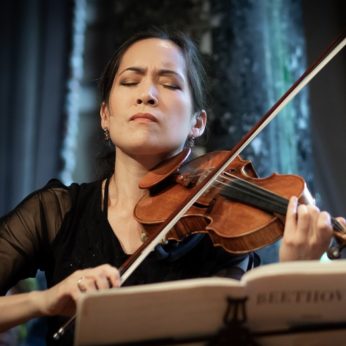Composer: Ludwig van Beethoven (b. 1770 - d. 1827)
Performance date: 01/07/2019
Venue: Bantry Library
Composition Year: 1808
Duration: 00:32:28
Recording Engineer: Ciaran Cullen, RTÉ
Instrumentation: fl, ob, cl, bn, hn
Instrumentation Category:Trio
Artists:
Barry Douglas -
[piano]
Johannes Moser -
[cello]
Viviane Hagner -
[violin]

Ludwig van Beethoven [1770-1827]
Piano Trio in E flat Op.70/2 [1808]
1. Poco sostenuto – Allegro ma non troppo
2. Allegretto
3. Allegretto ma non troppo
4. Finale, Allegro
Beethoven’s first published work was a set of three ground-breaking piano trios, which effectively established a completely new conception of the combination of violin, cello and piano. It had begun in the eighteenth century as a variant of the sonata for violin and keyboard, with the violin sharing the melody with the keyboard’s right hand, but with bass line in the keyboard’s left hand, relatively weak in early fortepianos, reinforced by the cello. Haydn’s thirty or so piano trios are written in this way; and the same approach underlies Mozart’s trios, although the violin is given a greater share of the melodic lead and the cello is later allowed a modicum of independence. Beethoven goes much further, completely unshackling the cello from its subservient role, and creating works on a totally different scale to anything that had been written either Haydn or Mozart.
This Trio has a mysterious slow introduction that inserts itself several times into the melodious and cheerful Allegro that follows as a counterpoint to the unrestrained optimism of that movement. This work dates from the same year as the A major Cello Sonata so we can expect broad flowing melodies and an indulgent attitude towards big tunes, giving them plenty of space to develop. This is very much the case in the delicious Allegretto which is a set of double variations, treating alternately one theme in C major and another in C minor. As the movement proceeds he treats the plan with great freedom, ending with a long C minor coda based largely on the first theme with its distinctive Scotch snap rhythm.
The third movement, with yet another of Beethoven’s captivating tunes, is not quite a minuet nor yet a scherzo – more a lyrical intermezzo of the kind that was later favoured by Brahms. The Trio section first pits the strings in three-part harmony with the violin double-stopping against the piano in four-bar exchanges, and continues with an episode of magically shifting harmonies, decorated by the piano at the very top of its compass. Beethoven clearly enjoyed his creation for he brings it around twice.
The finale begets another brilliant idea, given plenty of exposure and clad in lots of unexpected keys. This generates huge amounts of energy and gives the movement the kind of breadth we expect from works written in this period of Beethoven’s life, it just gets better and better.
Francis Humphrys
Copyright © 2024 West Cork Music. All rights reserved.
Designed and developed by Matrix Internet